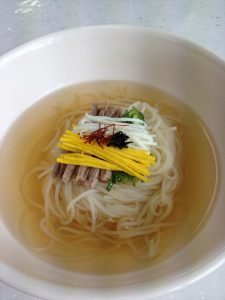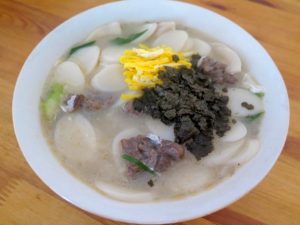Ever since the Portuguese explorer Magellan set foot on foreign land, the humanity has been passionate about exploration and globalization. In a society where technology is so advanced and trade prospers, countries have interactions with one another. Such has led to immense dissemination of cultures. Everything from food to language has crossed borders to reach people all throughout the world. This is the case for Italian culture as well; its culture has expanded beyond its territory to countries all over the planet, especially the United States of America. A famous dish in Italy, pasta has endearing meaning to Italians. Its influence is so prominent in the U.S. that Italian cuisine, such as spaghetti, is often confused as American dishes. The history of Italian pasta in the United States is fairly short, but its significance to locals and immigrants alike is substantial.
Pasta has multiple meanings in Italian, but it most directly translates to the term “paste” (History Kitchen). This term is used to define various food items in Italian, from noodles to pastries, but in the context of this essay, it means a form of noodle made from “unleavened dough consisting of ground durum wheat and water or eggs” (History Kitchen). It is crucial to specifically highlight the use of durum wheat in traditional Italian pasta, for this is the key ingredient that distinguishes it from other wheat noodles. The durum wheat dough is cut into different shapes of varying sizes well suited to each type of dish being made. A precise chronicle of pasta is difficult to delineate, but its cultural significance has been growing and abounding in the nation since about the 13th century (History Kitchen).
Some theorize that pasta was brought to Italy by Marco Polo in the 13th century (Lopez). Many believe that Polo brought the concept of wheat-based noodles from his adventures in Central Asia, particularly China (Lopez). This theory is heavily based on the book Polo wrote called Divasament dou Monde, commonly known as The Travels of Marco Polo (Culinary Lore). Polo supposedly wrote extensively about a new type of pasta that he discovered in China, leading people into assumptions that Polo brought this newfound food into Italy (Culinary Lore). A frequent mistake in anthropological studies have been made in such assumption; meaning was lost during translation and oral retellings of this book, for its original copy had been lost (History Kitchen). If one goes back in time and examines a relatively accurate Italian version of the text, however, he or she will learn that the descriptions of Chinese pasta was based off of what Polo had already known about (Culinary Lore). The illustration of “Chinese” pasta was far too familiar to be something Polo had never seen before, as if he was describing something that already had designated terms for (Culinary Lore). With many more texts and evidences that exist that dates well before Marco Polo’s travels to China, this theory is rather incredulous (Culinary Lore). The very first introduction of pasta still remains a mystery.
Early renditions of pasta were called “macaroni,” which translates to “kneading dough with energy” in Sicilian dialect (Demetri). It did not simply refer to the shape of pasta that we normally see in a macaroni and cheese dish; it described any type of noodles that were served as a meal in the olden days. Macaroni dishes gained its popularity in Sicily, for durum wheat was a staple in this sunny island. As more people were exposed to macaroni, durum wheat traveled to mainland Italy, where it thrived (Demetri). Pasta became a well-known dish all throughout Italy.
More variations in shapes came to rise as more people came to favor pasta dishes. Cooks and mothers began to invent more shapes to make pasta more suitable for the sauce they were making, and today, more than 300 different types of pasta shapes, from penne to racchette, exist, all made out of durum flour and water (Demetri). Often these noodles are dried to ensure longer shelf life (Demetri). As the world was getting ready to expand, more voyagers set sail into the new world, where these pastas were often cooked and eaten on boats (Demetri). Drying the pasta allowed explorers to eat an adequate meal, even away from home (Demetri).
These voyages into the New World were not just important for the invention of dried pasta commonly consumed today, but it also played a major role in the stereotypical pasta sauce eaten this very day: tomato sauce. Italy did not have tomatoes to eat until the 19th century, when the Spaniards brought this plant to Italy during their invasions (Demetri). Tomatoes weren’t the only things that the Spaniards introduced to Italians; through these invasions that Italy faced, the concept of family, a key principle in Italian families today, grew thicker and prevailed in the hearts of Italians. Through many invasions in addition to Spanish invasions, Italy faced numerous struggles. This allowed families to bond and share the true importance of one another.
This significant strand of culture was brought to the United States in the late 18th century (Cannato). Destruction and dejection left behind by World War I sparked a massive surge of immigration into the United States (“How Pasta Came to America”). Shrugging off the impact of the war, Italians, typically those from Southern Italy, headed to the U.S. to live the American dream, settling mostly in the East Coast, such as Boston and New York City (“How Pasta Came to America”). When immigrants arrived in the U.S., it was common for them to assimilate into American culture, for it was their new home (Cannato). Yet it was significant for Italians to integrate into American culture, not in a “melting pot” kind of way, but in a “salad bowl” way (Cannato). Though many settlers learned to speak English and adopted American customs, it was critical that they maintain their culinary traditions (Cannato). Language and ways of thinking can go, but food needed to remain. Customarily, before immigrating to the U.S., Italians were famous for pride in their regional recipes. Cooking culture and methods differed from one region to another, and it was important for individuals to abide to their local recipes. However, those who relocated to the United States soon realized that they were living with Italians of diverse origins (Toscana Divino). There were people from Sicily, while others traveled from Rome. Naturally, these groups of people began to cooperate with one another, and culinary cultures fused into one culture known as Italian-American cuisine (Toscana Divino).
Because most Italian settlers in the United States was from Southern Italy, restaurants mainly served dishes typical of Southern Italy: pizza, pasta with tomato sauce, and pasta with olive oil (McMillan). Meatballs, already popularly consumed in the U.S., was eaten together with Italian pasta, giving rise to a widely favored and accepted dish: spaghetti and meatballs (McMillan). The ingredients that were ordinarily found in Southern Italy could not be found in the U.S. For instance, the type of tomato that was used to make tomato-based sauce in mainland Italy was called plum tomatoes (Montany). Plum tomatoes were ideal for making quickly making pasta sauces, for its skin was thin and lacked seeds (Montany). However, settlers in the U.S. found that the tomatoes commonly found in American markets during the 19th century were completely unlike plum tomatoes; these American tomatoes had thick skin with a great deal of seeds (Montany). This dissimilarity of ingredients, though technically the “same” ingredient, called for a deviation from traditional recipes. Immigrants had to adjust their recipes by adding increasing the amount of sugar and garlic added to the sauce (Montany). The sauce also had to be cooked longer to fully cook the thick skins of American tomatoes (Montany). As a result, the pasta sauce became thicker and chunkier, just like the sauce in a classic Italian-American dish. Slowly, more Northern Italians began to emigrate out of Italy and immigrate into the United States, cooking less with tomatoes and introduced risottos and wine-based pasta sauces (McMillan).
Upon the arrival of non-tomato-based pasta dishes, there was an introduction to the well-adored dish today: Fettucine Alfredo. This creamy dish with thick, wide noodles was not initially cooked in the U.S. Though this story may not be accurate, it is widely believed that this dish was first developed by a man known as Alfredo. A chef at a renowned restaurant, Alfredo was struggling to keep his wife satiated; she was pregnant and was suffering from nausea that could not be controlled (“Is Fettucine Alfredo”). Just like the majority of Italian homes, Alfredo’s house placed great importance on unity and care for families, and this was brought to his family through noodles. Rumor has it that Alfredo made his wife pasta with parmesan and butter, and his wife was in love with it (“Is Fettucine Alfredo”). At his restaurant, Alfredo introduced his customers to his newly invented pasta dish, and it received extraordinary praises. Mary Pickford and Douglas Fairbanks, a couple from the United States, was able to buy this recipe from Alfredo and bring it back to the U.S., where different variations of this dish arose (“Is Fettucine Alfredo”). Instead of the relatively light nature of butter and cheese, Americans demanded thicker, creamier texture and flavor. More ingredients, such as chicken, seafood, and broccoli, were added to this pasta to enhance the flavors as well. An initially Italian dish made to satiate not only hunger but also values of a family in Italy, Fettucine Alfredo became a prominent dish in the U.S. as an Italian-American dish, perhaps bringing together both the locals and immigrants together.
Preference held by Americans also altered the ways in which Italian immigrants cooked, especially in their restaurants. As a consequence of immense invasions, Italian food had Spanish and Mediterranean traces. One of the main sources of ingredients was eggplants and cheese. As a result, an extremely popular dish in Italy was Mellenzana alla Parmigiana, or Eggplant Parmigiana (“The Story Behind”). This dish called for deep-fried eggplants to be topped with a light tomato sauce – one made with traditional Italian recipe with thin plum tomatoes (“The Story Behind”). The dish is finally garnished with Parmesan cheese, making the dish saltier and creamier. Mellenzana alla Parmigiana is hugely homologous to a quintessential Italian-American dish: Chicken Parmigiana, or more commonly referred to as chicken parm (“The Story Behind”). In fact, Chicken Parmigiana uses the same recipe as the Mellenzana alla Parmigiana, only substituting chicken with eggplants. Contrary to Italians whose diet was often based on fresh vegetables and seafood, those living in the U.S. preferred protein-heavy dishes, such as chicken, to light, vegetable-based meals (“The Story Behind”). Immigrant chefs began to use chicken instead to suite the American palate (“The Story Behind”). In addition, due to an increase in acceptance of Italian-Americans, these expatriates began to rise in social status. Thus, their income increased, making it possible for them to afford meats (“The Story Behind”). Also, the mild, fresh sauce used in Mellenzana alla Parmigiana was also adjusted to the thicker, American version of the sauce, as mentioned earlier. The immigrant chefs also added pasta to serve alongside these chicken dishes, possibly to share with Americans what was important in their culture. This dish is eaten and enjoyed by people all throughout the globe, often referred to as a classic American dish.
Despite the widely modified versions of Italian cooking in the U.S., there is one thing that never changed: significance of family and food. These two things remained important to a typical Italian-American family, according to a second generation Italian-American blogger, Paul Nauta. They combined to bring out the inner Italian of these immigrants. “Nothing brings more joy in an Italian home than traditional food influenced by the old country,” Nauta mentioned in his blog. The importance of pasta and noodles in general are “a way of life that, although a family may be generations removed from the old country, still permeates every element of the family culture from generation to generation” (Nauta). Paul Nauta’s family, though citizens of the United States today, still emphasize the importance of cooking at home, so they can better connect to their roots back in mainland Italy.
It was common for Nauta’s family to eat at home growing up. It’s not that their family did not have the money to afford food outside, but the love for cooking was handed down to Nauta’s mother by his grandmother, who, in fact, passed down her very own recipe book to all her children. Cooking was what Nauta’s mother, Anna Michelli, grew up seeing, and she continued to do the same for her children. Although Anna Michelli was a chef at a local school cafeteria, she proceeded to cook at home, never letting go of her culinary work (Nauta). To Nauta, this is what “made everyone feel like family” (Nauta). Cooking was not just limited to mothers of the family, though they became symbols of fine, homecooked meals. Everyone was taught how to cook some sort of family dish, for it was considered a “family affair” (Nauta). Together, as family members learned how to cook, they were brought together, with children learning to respect elders and adults teaching kids about the importance of Italian heritage. As Professor Christine Ristaino mentioned in lectures, it is common for Italian immigrants in the U.S. to actually spend three days to make a sauce the traditional way, whereas those living in mainland Italy often take a couple hours to make their sauce. It seems as if immigrants are able to connect with their traditions by pouring their best efforts into cooking, learning about the efforts and values that is included in a dish of pasta.
Another vital element of Italian family is religion, specifically Catholicism. Prayer and thanksgiving start and end each meal, and every Sunday is dedicated to masses. Without Catholicism, Italians would not exist. Especially to immigrants, going to church and praying every day were important aspects to keep up, for it connected them to the roots back home. Churches formed communities, and these communities allowed Italian-Americans to share their culture and indulge in their traditions in a foreign land. These families and communities were of great importance to Italian-Americans, so many families and friends visited one another to share meals. Italian mothers often cooked more than just for their family members, according to Nauta, for there were always guests that came over to eat with them. The amount of food cooked each night was sufficient enough to feed everyone until they were full, not leaving anyone out, but welcoming visitors as family. Pasta and other dishes “brought groups of migrants together each day,” genuinely underscoring the importance of food in Italian culture (“Il Ventre di Torino”).
Over a meal of pasta, Italian-Americans are able to connect with their roots in multiple ways. The importance of family in Italian culture was certainly emphasized when Italian-American families ate and cooked with one another, appreciating one another’s presence along the way. In addition, the value of religion is also clearly evident in noodles in subtle ways. Before and each bowl of pasta, prayer is spoken, and thanks are given. Pasta eaten away from home touches the heart and soul of each Italian-American in multifaceted ways, possibly more than any other cultures in the United States.
Pasta is not just a simple dish without depth. Its profundity expands beyond borders and brings people together, especially Italian-Americans. Because of pasta, first Italian immigrants were able to withstand homesickness and discrimination and climb up the social ladder to where they are today. Because of pasta, Italian-Americans are able to connect with their heritage. And because of pasta, people of other cultures and origins are able to experience a glimpse of Italian culture away from Italy. Through pasta, the world is brought together, and it most certainly is an important ingredient in global peace that cannot be removed whatsoever.

 (
(
